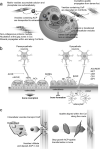Biomineralization of bone tissue: calcium phosphate-based inorganics in collagen fibrillar organic matrices
- PMID: 36068587
- PMCID: PMC9450317
- DOI: 10.1186/s40824-022-00288-0
Biomineralization of bone tissue: calcium phosphate-based inorganics in collagen fibrillar organic matrices
Abstract
Background: Bone regeneration research is currently ongoing in the scientific community. Materials approved for clinical use, and applied to patients, have been developed and produced. However, rather than directly affecting bone regeneration, these materials support bone induction, which regenerates bone. Therefore, the research community is still researching bone tissue regeneration. In the papers published so far, it is hard to find an improvement in the theory of bone regeneration. This review discusses the relationship between the existing theories on hard tissue growth and regeneration and the biomaterials developed so far for this purpose and future research directions.
Mainbody: Highly complex nucleation and crystallization in hard tissue involves the coordinated action of ions and/or molecules that can produce different organic and inorganic composite biomaterials. In addition, the healing of bone defects is also affected by the dynamic conditions of ions and nutrients in the bone regeneration process. Inorganics in the human body, especially calcium- and/or phosphorus-based materials, play an important role in hard tissues. Inorganic crystal growth is important for treating or remodeling the bone matrix. Biomaterials used in bone tissue regeneration require expertise in various fields of the scientific community. Chemical knowledge is indispensable for interpreting the relationship between biological factors and their formation. In addition, sources of energy for the nucleation and crystallization processes of such chemical bonds and minerals that make up the bone tissue must be considered. However, the exact mechanism for this process has not yet been elucidated. Therefore, a convergence of broader scientific fields such as chemistry, materials, and biology is urgently needed to induce a distinct bone tissue regeneration mechanism.
Conclusion: This review provides an overview of calcium- and/or phosphorus-based inorganic properties and processes combined with organics that can be regarded as matrices of these minerals, namely collagen molecules and collagen fibrils. Furthermore, we discuss how this strategy can be applied to future bone tissue regenerative medicine in combination with other academic perspectives.
Keywords: Biomineralization; Bone growth; Bone regeneration; Collagen matrix; Hierarchical structure; Nucleation and crystallization.
© 2022. The Author(s).
Conflict of interest statement
The authors declare that they have no competing interests.
Figures












References
-
- Madni AM. Disciplinary Convergence. Transdisciplinary Systems Engineering. Cham: Springer International Publishing; 2018. pp. 41–7.
-
- Convergence: Facilitating Transdisciplinary Integration of Life Sciences, Physical Sciences, Engineering, and Beyond. The National Academies Collection: Reports funded by National Institutes of Health. Washington (DC): National Academies Press (US); 2014. - PubMed
Publication types
LinkOut - more resources
Full Text Sources

